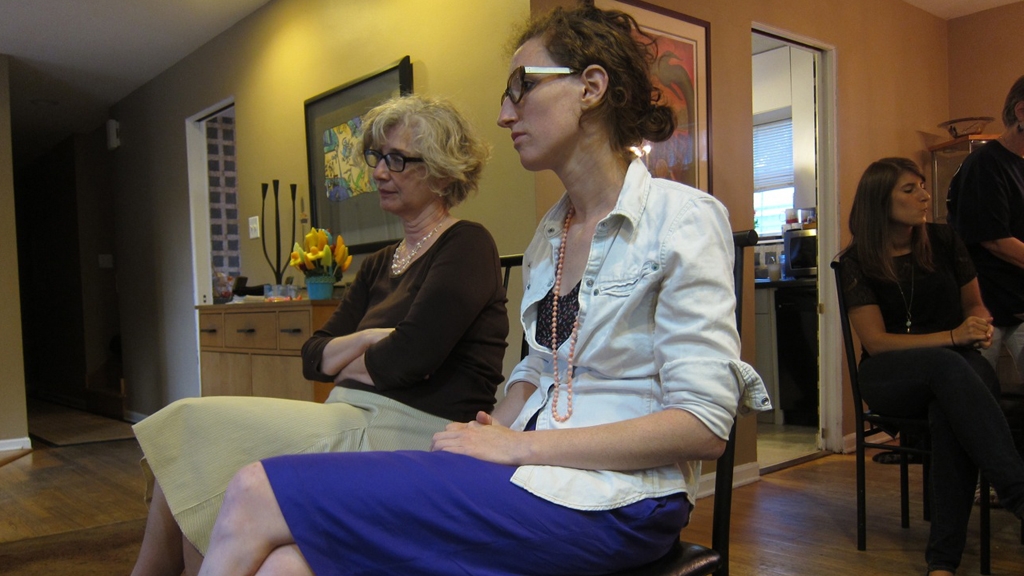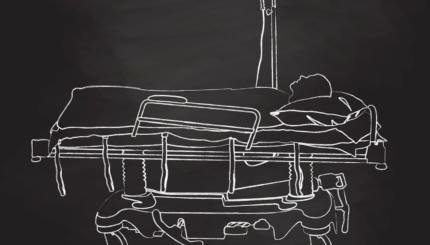[the seven days of intensive mourning that follows the death of a relative]is traditionally observed either in the home of the deceased or in the home of a principal mourner. If possible, mourners spend the whole week in the shiva house together, sleeping under the same roof. Where this is not practical, mourners share their waking hours.
Transformation of Space During Shiva
Just as shiva transforms how mourners pass time, it also changes the look and use of space.
Sitting Low to the Ground
Sitting low to the ground–on the floor, on cushions, or special benches provided by the funeral home–is an outward sign of being struck down by grief. (Visitors sit on regular chairs and couches.)
Covering the Mirrors
The practice of covering the mirrors began centuries ago and was based on a belief that spirits were attracted to mirrors. Some people thought that the soul could be trapped in the reflection or that the dead person’s spirit lingered on earth for a time and might reach out from “the other side.” The rabbis reinterpreted the folk custom, declaring that mirrors should be covered to discourage vanity and encourage inner reflection. Regardless of its symbolism, covering mirrors is a striking visual cue, a token of the disruption and grief felt by everyone who enters the house.

Help us keep Jewish knowledge accessible to millions of people around the world.
Your donation to My Jewish Learning fuels endless journeys of Jewish discovery. With your help, My Jewish Learning can continue to provide nonstop opportunities for learning, connection and growth.
Unlocked Doors
Doors are traditionally left unlocked so that visitors can enter without knocking or ringing the doorbell, which would distract the mourners from their grief and cause them to act as hosts.
Condolence Book
A condolence book (often provided by the funeral home) may be set out in a prominent spot. This can be a useful record if family members wish to write thank-you notes to visitors. Condolence books and thank-you notes are American secular and Christian customs that have been adopted by many Jews. Though traditionally one would never thank someone (or expect to be thanked) for fulfilling a [commandment] as profound as honoring the dead or comforting the bereaved, many people find that writing to visitors and answering sympathy cards are part of the healing process.
Other Common Objects in a Shiva Home
Other common objects in a shiva home include a seven-day memorial candle, and prayer books for [required quorum of ten] services [at which the mourner says , the memorial prayer]. Jewish funeral homes or your synagogue will generally provide these in a shiva”kit” that might also include low benches or chairs, folding chairs for guests, and kippot.
Beginning of Shiva
Shiva starts when the mourners return home from the funeral. The rituals are elemental, and for the most part wordless.
– Shoes: Mourners remove their shoes and refrain from wearing leather shoes–an ancient sign of luxury–while in the shiva house. Wearing cloth slippers, socks, or going barefoot is a sign of being humbled by loss.
– Water: A basin of water and a towel may be left outside the door for people to wash their hands, a ritual gesture that separates the mitzvah of honoring the dead from the mitzvah of comforting the bereaved. (This is usually done at the cemetery.)
– Light: It is customary to light a large shiva candle, also called a ner daluk–burning light–which burns for seven days and nights. Candles are universal symbols of the divine spark that inhabits the body. In the words of the Bible, “The soul is the lamp of God.” The candle is placed in a prominent spot and lit without saying a blessing. The immediate family might gather and designate someone to light the flame; this honor can go to a child, close friend, or other “unofficial” mourner. The funeral home provides a long-burning candle or a special electric light that stays lit throughout shiva.
– Food: Serving a meal [seudat ha-havra’ah or meal of condolence] to mourners upon their return from the cemetery is a tangible act of condolence. Although the bereaved tend to be uninterested in eating, friends provide nourishment to signal that life must go on.
Reprinted with permission from Saying Kaddish: How to Comfort the Dying, Bury the Dead, & Mourn as a Jew (Schocken Books).
Anita Diamant’s books include Choosing a Jewish Life, The New Jewish Wedding, Living a Jewish Life, and The Red Tent, a novel. She lives in Newton, Massachusetts.
Sign up for a Journey Through Grief & Mourning: Whether you have lost a loved one recently or just want to learn the basics of Jewish mourning rituals, this 8-part email series will guide you through everything you need to know and help you feel supported and comforted at a difficult time.
Looking for a way to say Mourner’s Kaddish in a minyan? My Jewish Learning’s daily online minyan gives mourners and others an opportunity to say Kaddish in community and learn from leading rabbis.



